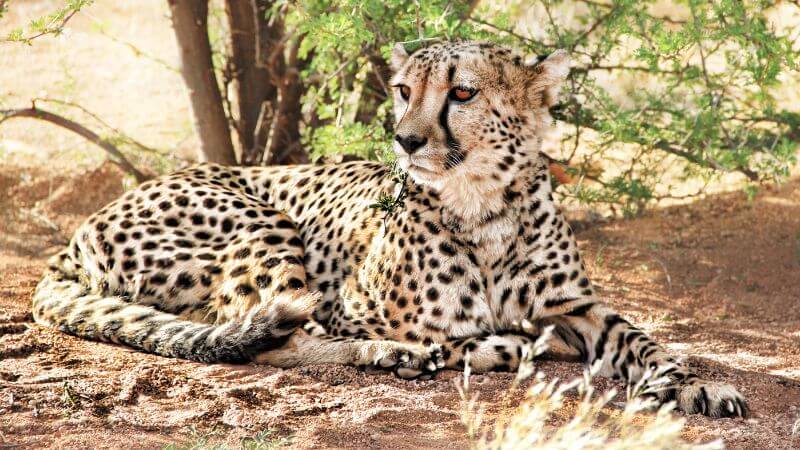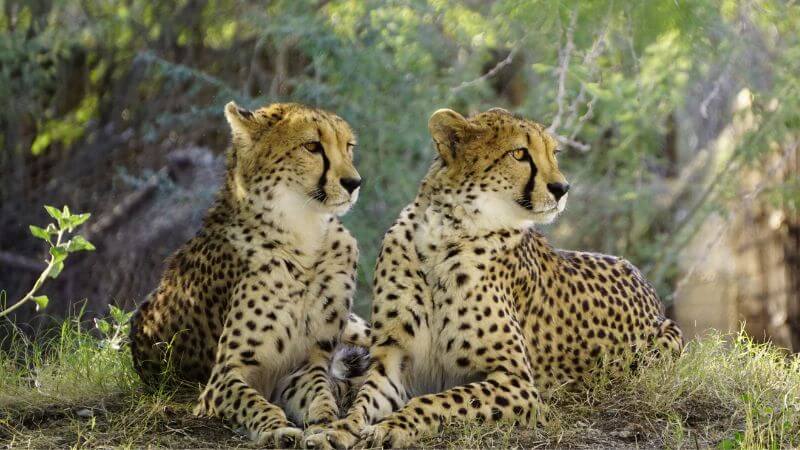Eight cheetahs from Namibia were released into enclosures at the Kuno national park in Madhya Pradesh. Today, Prime Minister Narendra Modi released them. Seven decades after being declared extinct in the nation, it was carried out as part of efforts to reintroduce feline to India. The large cats were transported by helicopter to their new home.
Prime Minister Narendra Modi releases 8 wild cheetahs brought from Namibia, in the Kuno National Park. #CheetahIsBack #IndiaWelcomesCheetah #ProjectCheetah pic.twitter.com/DbP6cRMS5n
— All India Radio News (@airnewsalerts) September 17, 2022
All cheetahs have radio collars, which will be tracked through satellite. A specialized monitoring staff will be behind each cheetah in addition to this. Officials stated that they would continue to monitor the location for 24 hours. So, here are 15 interesting facts about Cheetahs, the “big cats.”
1. Cheetah Is The Fastest Terrestrial Animal

The cheetah, accelerating from 0 to 60 miles per hour in less than three seconds, is the fastest land animal. However, a cheetah only chases prey for 200–300 meters at most. The fastest animal on solid ground is currently this large cat. Its lean, strong body and implacable claws assist in traction. The large cat’s body is designed for speed, with long legs, a long neck, and a small head. As a result, they have great mobility when moving through space. They are also quicker than the majority of supercars. At peak speed, their stride length reaches a maximum of 7 meters.
2. Cheetahs Tail Help Them To Maintain The Balance

The flat-shaped, muscular tail of the cheetah is long and broad. The tail almost works like a boat’s rudder. It’s because they use it to help regulate their steering and maintain their balance when they run fast. The long tail of a cheetah serves as a balance for quick turns. During high-speed chases, the flattened tip of the tail serves as a rudder to direct direction. The length of a cheetah’s tail ranges from 60 to 80 cm and is almost as long as its head and body.
3. Cheetahs Meow And Purr, Not Roar
Wait is over.. ready to come to India…#CheetahIsBack pic.twitter.com/WaRkTuVe1I
— Dr.Samrat Gowda IFS (@IfsSamrat) September 17, 2022
The sounds a cheetah makes are not frightful. Cheetahs sound more like domestic cats than lions, who are renowned for their fierce roars. They purr and meow. Additionally, they chirp and churn. The epihyal bone in the voice box is absent in other big cats, allowing them to produce scary noises. Lower noises are produced as ligament stretches. Cheetahs have split vocal cords and a fixed voice box. It permits them to purr but restricts the noises they can produce, similar to “small cats.”
4. Adult Female Cheetahs Usually Live Alone

Female cheetahs leave their mother and siblings after spending the first eighteen months of their lives together. They do all of their hunting, mating, and childraising. Male cheetahs have a significantly different life cycle than other animals, remaining in very sociable groups of 2 to 6. This shift in gender roles is incredibly unusual. Additionally, it is the opposite of what regularly happens in the animal world. Except for raising a litter, female cheetahs live alone. Mother and their cubs typically lodge together close to one another. Female cheetahs only interact with one another during mating season.
5. The Cheetah’s Spots Serve As Camouflage

The cheetah’s spotted fur makes it easier to disappear into its surroundings. This can make it easier for them to stalk and hunt their prey. The cubs may hide from lion and hyena predators due to the cheetah’s camouflaged hide, which contributes to protection. The fur on the cub’s head, neck, and back develops into a mantle in addition to having spots. The cub can more easily blend into its surroundings owing to its longer fur, which makes it look like grass blades. When hunting or hiding from predators, the cheetah’s 2,000–3,000 spots might assist it in blending with its surroundings.
6. Cheetahs Have A Very Long History

Based on carbon dating, some cheetah fossils have an estimated one and two million years before. Years ago, a completely intact skull of a prehistoric cheetah was discovered in China. It implies that the swift cats were not native to the Americas but rather to the Old World. The skull was found in China’s Gansu Province. It is believed that the animal lived between 2.2 and 2.5 million years ago, making it one of the earliest cheetah fossils ever discovered.
7. Being A Predator Is Also Challenging

The majority of the prey that cheetahs chase are small to medium-sized ungulates. They can, however, also eat small mammals like hares and ground-dwelling birds. Cheetahs rarely scavenge, in contrast to other predators in Africa. Instead, they have a reputation for eating their prey rapidly and moving on when they see other predators. This is especially true in regions where there are many huge carnivores. In the end, lions and spotted hyenas steal about 10% of cheetah kills. The preference of cheetahs to hunt during the day, when other predators are less active, is understandable by this.
8. Mating Season For Cheetahs

Female cheetahs’ estrus is unpredictable. This is one of the reasons why breeding cheetahs in captivity are challenging. The proximity of males and their scent marks stimulate environmental conditions that affect mate receptivity. Females will mate with several males during the 14-day estrus cycle. The male cheetahs will remain with her and mate with her for up to three days.
9. Cheetahs Are Vulnerable To Extinction

Cheetahs were historically common throughout Africa, as well as in the Arabian Peninsula and central India. However, they are no longer present in the majority of Africa. Only 10% of their former range is still home to them today. The current home of the cheetah is in Southern and Eastern Africa. Wild cheetah populations in Asia have experienced a startling fall. Asian cheetahs are currently present in Iran’s central deserts. Threats ranging from habitat loss to infrastructural development affect the remaining cheetah populations.
10. Mortality Rate For Cheetah Cubs Is High

It’s challenging to estimate life spans in the wild. Males, in particular, because they travel around a lot. According to reports, cheetah cub mortality is high. Issues with genetic diversity can be a cause. 29% of the cubs in one study of cheetahs born in captivity died within six months. Only half of them made it to adulthood. Compared to most other animal species examined, their newborn mortality rate is far greater. Cub mortality is higher in protected areas like national parks and wildlife reserves. It is where proximity to large predators is greater than in non-protected areas.
11. Role Of Cheetah In The Ecosystem

Any ecosystem benefits from the presence of predators. By removing the frail and elderly, they maintain the health of the prey species. They also serve as population control, benefiting plant life by reducing overgrazing. The Namibian ecology would be substantially different in the absence of predators like the cheetah. Additionally, desertification, a prevalent natural trend, will increase.
12. Physical Features

The body of these large cats can reach lengths of 1.1 to 1.4 meters. They also have a tail that ranges in length from 65 to 80 cm. They weigh from 34 kg to 54 kg, with males being significantly heavier. Cheetahs have a white underbelly and a pale yellow upper body with black spots. Black lines that arc from each eye’s inner corners to the mouth’s outer corners help to identify their faces.
13. How Often Do Cheetahs Drink?

Cheetahs have evolved to exist in an area with limited access to water, unlike other animals. As a result, they can go three to four days without a drink.
14. They Start Their Families Early

Cheetahs begin having offspring at an early age. Males at one and females at two years old. There is no particular time of year when they reproduce. After mating, male cheetahs leave the females and have no part in caring for the cubs. On the other side, female cheetahs are loving and caring mothers. Female cheetahs will give birth to a litter of 2 to 8 cubs in a remote location after a three-month pregnancy.
15. Life Span Of Cheetah

A cheetah’s adult existence in the wild is challenging. Cheetahs live 10 to 12 years on average in the wild. In the wild, adult males live shorter lives on average (8 years). It results from territorial disputes between male rival groups. Adult mortality is one of the most important factors restricting the expansion and survival of the wild cheetah population.
Eight cheetahs, three males, and five females, live on a foreign continent far from their natural habitat. Before they would accept India as their new home, they would need a long time.
Follow Us: Facebook | Instagram | Twitter |
Entertales is on YouTube; click here to subscribe for the latest videos and updates.














